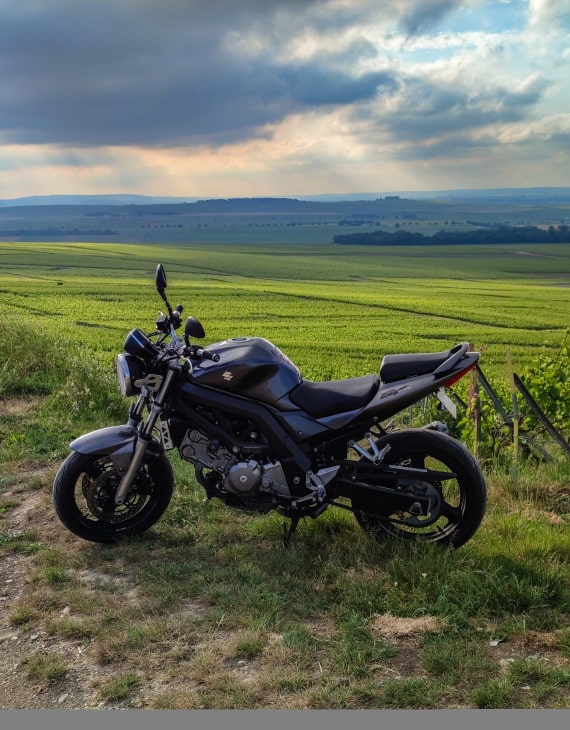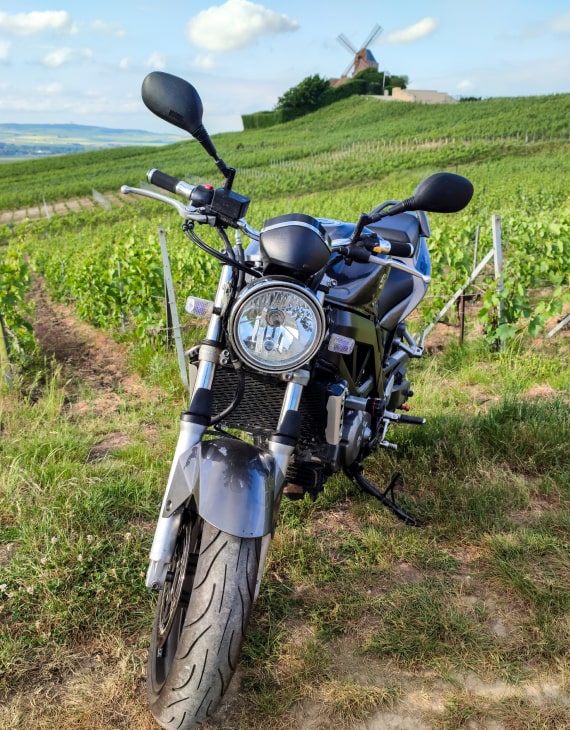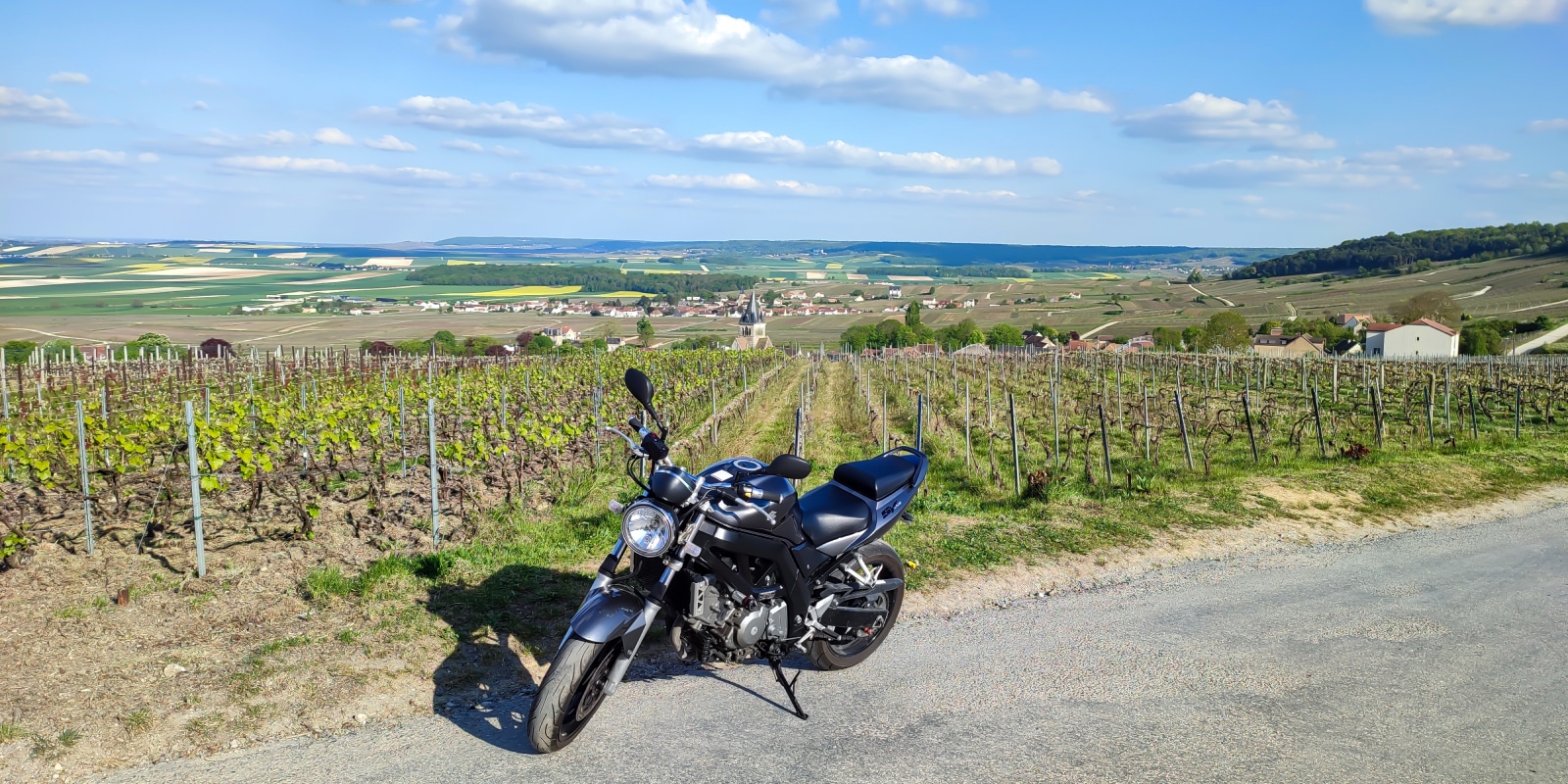Drive in Champagne !
If you are a biker at heart or if you simply like to go for a ride on a two-wheeler on a sunny day, we suggest you visit the Champagne region by motorcycle! Let yourself be tempted by a memorable ride through breathtaking landscapes, home to the most beautiful panoramas: from the paths bordered by the hillsides in the heart of Champagne to the majestic forests and plains, you will live an unforgettable experience. A wide range of carefully prepared wide range of is waiting for you. An ideal playground for a successful trip!
Start : Reims (51) / Distance : 171 km
From Reims to Laon, only 50 kilometers separate these two cities, but there are two different atmospheres thanks to two very distinct mountains.
On the one hand, Champagne, the region of the city of the sacres, the capital of Champagne and other nuggets. On the other hand, the Aisne, a region with a strong history and memory, is at the gateway to the Champagne region and has many other treasures.
REIMS > FISMES
Emblematic of Reims, the angel with the famous smile watches over the Notre-Dame de Reims cathedral, a world heritage site, and the memories that link it to the history of the kings of France and the archbishops’ palace, known as the Tau, which adjoins it. It is one of the most impressive in France. It would take a full day to go on an adventure through its streets and alleys to tour the city and its main monuments.
Reims was not spared by the battles of the 20th century. The city was 80% destroyed by German bombing during the First World War and a fire even destroyed the frame of the magnificent cathedral, melted the bells and shattered the stone in September 1914. Restored, Notre-Dame received a flammable concrete frame.
During the Second World War, only the area around the station was affected. Reims knew its hour of glory in this conflict since it is in the Roosevelt high school, transformed into Eisenhower’s HQ, that the act of surrender of the German forces was signed, on May 7, 1945.
Save the visit of the great champagne houses for the end of the day and leave Reims by the south, towards the Montagne de Reims. Surrounded by forests, this hill (highest point 288 meters) crowned by a plateau is part of the Regional Natural Park. No great wilderness, however, it is dotted with villages dedicated to the culture of wine. You will first discover Verzenay, dominated by a windmill to the west and by an aerial lighthouse, built in 1909 and reconverted into a museum of the Vine.
Just after, find VerzyOn the other side of the D34, another parking lot gives access (10 minutes on foot) to the observatory of Mount Sinaicreated after the liberation of Reims in 1914, with an amazing view on the city and the Champagne mountains.
After a short drive in the Reims Mountains, you will leave through Ay-Champagne, a vineyard already famous in Gallo-Roman times.
Then join Hautvillers, a charming wine-producing village “perched” at an altitude of 250 meters: in addition to the wine press located at the entrance of the village, take the time to admire the hundred or so hand-painted wrought-iron signs along the streets.
Continue under the foliage through Nanteuil-la-Forêt, Poury (which houses the Maison du Parc), and then Marfaux. Once out of the forest, stay on the D386 which leads you straight through the Champagne countryside to FismesThis small town marks the boundary between the Marne and Aisne departments, between Champagne and Picardy, between the country of the Montagne de Reims and that of the “Colline éternelle” of Laon.
The Cathedral of Reims is open every day from 7:30 am to 7:30 pm, and until 7:15 pm on Sundays and religious holidays. Please note that during religious services, visits are interrupted. It is possible to rent an audioguide at the Reims Tourist Office or to take a guided tour, count on average 9€ per adult and 4,5€ per child over 12 years old.
2 place du Cardinal Luçon - 51100 Reims - T 03 26 47 81 79
Admission 8€.
Open from September 9, 2021 (except Monday) from 9:45 am to 12:30 pm and from 2:00 pm to 5:15 pm.
Open from May 6, 2022 to September 8, 2022 (except Mondays) from 9:45 am to 6:15 pm
Open from September 9, 2022 to May 5, 2023 (except Mondays) from 9:45 a.m. to 12:30 p.m. and 2:00 p.m. to 5:15 p.m.
Possibility of a guided tour (1h).
12 rue Franklin Roosevelt - 51100 Reims. Open every day from 10 am to 6 pm. Closed on Tuesdays and on January 1, May 1, November 1 and December 25
T. 03 26 47 84 19. Admission 5 €.
Fismes > Reims
At the time, Fismes was the last stop before Reims for the kings of France who came from Paris to be crowned. The city has kept part of its ancient ramparts, but the ditches were filled in the 18th century to become promenades. For the anecdote, Fismes was also the birthplace of the comic book artist Albert Uderzo, the “father” of Asterix. Have fun looking for the Goscinny-et-Uderzo alley in which a menhir stands.
Cross the river Vesle, a tributary of the Aisne, and continue your way north, towards Laon. Shortly after, arrival in the department ofAisne, and, a little further, pass the river which gave it its name, doubled by the canal of Oise. The village of Cerny-en-Laonnois marks the crossroads with the Chemin des Dames, which you will find soon. Then go to Laon.
The arrival to the south via Laon is less spectacular than the one via the north. One is less aware of the extent to which the old Carolingian city overlooks the plain by more than 100 meters. On the other hand, the southern side allows you to access the old town more quickly through the Porte de Soissons, as the new neighborhoods have developed to the north around the train station.
Before the revolution, people came from all over the kingdom of France to admire the seven wonders of Laon, some of which are still visible: the Notre Dame Cathedral, of course, completed around 1230, making it one of the oldest Gothic cathedrals in the country; the abbey churches St-Martin and St-Vincent (the second was destroyed during the Revolution); the leaning tower of Lady Eve ; l’pond of the monks of St-Vincentwhose level never drops; the Bone that hangsa half whale jaw brought back from England by canons in the 12th century and the Nail stoneNails driven by hand into a stone by a mother whose innocent children had been hanged.
After visiting the cathedral, the episcopal palace, the Templars’ chapel, the St-Martin abbey… leave the old city by the Midi rampart and the Ardon gate, followed logically by the Ardon ramp, which is a beautiful winding descent.
Nothing extraordinary until Bruyères-et-Montbérault, then the road comes to life and arrives at Chamouille. Turn left to go around the small lake. Continue straight ahead towards the Chermizy-Ailles exit where you will turn right to pass in front of the ruins of the abbey of Vauclair, ravaged by the bombardments of 1917.
Further on, at the crossroads d’Hurtebiseyou are back on the Chemin des DamesThis ridge is 30 km long and 8 km wide and corresponds to a vast sector, the scene of deadly fighting during the First World War, which extends north of the Aisne River for more than 30 km between Pinon to the west and Berry-au-Bac to the east. This path represents more than 70 villages, some of which disappeared during the war without being rebuilt, such as Ailles, Beaulne, Troyon.
In the continuity of the journey, on your right, the museum of the Caverne du Dragon which recalls the living conditions of the poilus of the Great War where approximately 150 000 lost their lives. By turning left towards Craonne, you arrive at the plateau of California leading to its belvedere with a view on the old village of Craonne and the reconstruction of the houses completely destroyed during the war. An arboretum, replacing the old Craonne, testifies to the power of the battles through its ground impregnated by shell holes. According to estimates, about one ton of shells per square meter would have crashed during the Great War… Slightly before the plateau, you have a beautiful milestone of the Chemin des Dames allowing you to decorate your film.
Continue on the road to Craonne towards Corbeny to join the D 944 which runs alongside the freeway and takes you back to Reims.

Bikers Home
On this itinerary you will find various hotels, guest houses, gites and vacation centers approved by Accueil Motards offering you the services and facilities you need.

Accredited accommodations Accueil Motards ®.
For an optimal reception and stay of the motorcyclists, the Grand Est Regional Tourist Agency and the Marne Tourist Development Agency have visited and validated the tourist accommodations that are committed to providing a certain number of services and facilities to tourist customers travelling on two wheels.
The hotels, guest houses, gites and vacation centers approved by Accueil Motards® are committed to offering the biker :
- a garage or secure parking for your motorcycle,
- a drying system for its equipment,
- the minimum equipment for small repairs,
- hot beverage service,
- tourist information and services useful for their stay.
For the lodgings, provision of bed linen and towels (possible surcharge) and possibility of reserving the first breakfast basket (optional and with surcharge).
You will find these criteria in detail in the Accueil Motards® quality charter, signed by the accommodation provider, and they are verified during visits to the accommodation carried out in the precious and rigorous presence of representatives of the Moto-Club d’Epernay and the departmental branch of the Fédération Française des Motards en Colère de la Marne.
Start : Château-Thierry (02) / Distance : 202 km
You will take a path in the middle of the vineyards on the hillside bordering the river Marne. Between country smells and forest passages, nice curves follow each other on this beautiful walk.
Château-Thierry > Dormans
Your itinerary starts in the birthplace of Jean de La Fontaine, where you can visit his house.
You will be able to stretch your legs with the walk of the castle revealing splendid views on the city, the valley of the Marne, as well as the monument of the hill 204. This memorial was built in 1933 evoking one of the most important battles of the Marne; where between June and July 1918 the 39th French and 2nd American divisions were slow to dislodge the German division. It is on the banks of the Marne that the decisive battles of the Great War took place.
Once the visits are over, it’s time to take the road again along the Marne River and follow a part of the famous Champagne Tourist Route.
Traditional stopover in Dormans where you will enjoy the peacefulness of the river banks. The Louis XIII castle opens the doors of its park, at the bottom of which lies the memorial of the Battles of the Marne on a site designated by Marshal Foch.
If you are looking for more motorcycle sensations, book your day at Les Écuyers in Beuvardes. If so, continue on the D 330. Before you enter the village of Jaulgonne, when you cross the first undergrowth, be very careful of the game that may appear on your way.
Dormans > Orbais l'Abbaye
On the way to Ay Champagnewhere the viewpoints on Épernay and the côte des Blancs are linked in the descent. Enjoy the landscape, you are in one of the most famous vineyards.
Then turn left on the D 1 to Mareuil-sur-Ay, where the castle built in the 18th century and acquired by the Duke of Montebello, son of Marshal Lannes, who made Champagne sold under his name.
In the heart of the regional natural park of the mountain of Reims is an atypical place placed in the heritage of UNESCO. The forest of Verzy and its scythes. They are twisted beeches with a gnarled and misshapen trunk, with a parasol-like top, whose branches form an astonishing interlacing of foliage. You will pass by it during your walk, the trunks are more visible when the leaves are not there.
Follow the direction ofEpernay to leave these forest roads and pass on the other bank of the Marne. Epernay, capital of Champagne where prestigious Houses are lined up on the Champagne avenue. Located above the chalk cliffs, there are about a hundred kilometers of galleries at a constant temperature (9 to 12°C).
Afterwards, you will cross Avize, a town known for its wine and for its viticultural high school which trains the future winegrowers of Champagne. To the west, above the city, the walk offers an extensive view. You continue on the D11 to make a stop in the village of Orbais-l’Abbaye.
Orbais, adorned with wooded hills, owes its reputation to its abbey church, founded in the 7th century, being part of one of the most remarkable Gothic buildings in Champagne. For the little anecdote, its construction was carried out by Jean d’Orbais, one of the master builders of the cathedral of Rheims.
Champagne is a white wine made from three grape varieties, two of which are black grapes: pinot noir and pinot meunier, and one of which is white grape, chardonnay. One vine stock can barely make one bottle of champagne. Each year, 300 million bottles are sold, of which 130 million are exported.
On your way, you may be intrigued by the presence of roses planted at the entrance of the vineyards. The latter are used to prevent winegrowers from diseases because roses, which are more sensitive, are the first to be affected before the vines are (such as mildew, chlorosis, powdery mildew, etc.).
Orbais l'Abbaye > Château-Thierry
At the crossroads of the Surmelin and Dhuis valleys, Condé-en-Brie was renamed Vallon libre during the Revolution. Its 15th-century frame hall that rests on Doric columns hosts the country market́ every 1st Sunday of the month over the period from April to October.
The road continues with a panorama of rolling fields and vineyards. You will pass near Château-Thierry, the starting and finishing point of this Champagne tour.
If you still have a little time and courage, continue along the Marne River, crossing the tributary of the Seine at Étampes-sur-Marne. The last step we propose is in Essômes-sur-Marne. You can visit the abbey church of St-Ferréol founded in 1090 by Hugues de Pierrefonds, bishop of Soissons, for the canons of the Augustinian order. Its interior is typical of the gothic style with lancets (heightened tiers-point arch, resembling a spearhead). The 38 choir stalls are in the Renaissance style. You are then at a few kilometers of the old hillock, flattened in 1060 by Hugues Lambert known as Thierry to raise a fortified enclosure there…
51270 Orbais l'Abbaye. Gothic abbey of the 7th century. Free admission.
Bikers Home
This itinerary is punctuated by hotels approved by Accueil Motards® offering you the facilities and services that best meet your specific needs (garage, drying, minimum equipment, useful information …).
